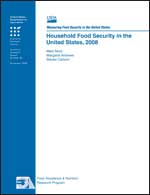Household Food Security in the United States, 2008
- by Mark Nord, Margaret Andrews and Steven Carlson
- 11/16/2009
Overview
Eighty-five percent of American households were food secure throughout the entire year in 2008, meaning that they had access at all times to enough food for an active, healthy life for all household members. The remaining households (14.6 percent) were food insecure at least some time during the year, including 5.7 percent with very low food security-meaning that the food intake of one or more household members was reduced and their eating patterns were disrupted at times during the year because the household lacked money and other resources for food. Prevalence rates of food insecurity and very low food security were up from 11.1 percent and 4.1 percent, respectively, in 2007, and were the highest recorded since 1995, when the first national food security survey was conducted. The typical food-secure household spent 31 percent more on food than the typical food-insecure household of the same size and household composition. Fifty-five percent of all food-insecure households participated in one or more of the three largest Federal food and nutrition assistance programs during the month prior to the 2008 survey.
Download
-
Entire report
Download PDF -
Report summary
Download PDF -
Download ERR83.zip
Download ZIP -
Abstract, Contents, and Summary
Download PDF -
Introduction
Download PDF -
Household Food Security
Download PDF -
Household Spending on Food
Download PDF -
Use of Federal and Community Food and Nutrition Assistance Programs
Download PDF -
References
Download PDF -
Appendix A?Household Responses to Questions in the Food Security Scale
Download PDF -
Appendix B?Background on the U.S. Food Security Measurement Project
Download PDF -
Appendix C?USDA?s Thrifty Food Plan
Download PDF -
Appendix D?Food Security During 30 Days Prior to the Food Security Survey
Download PDF


